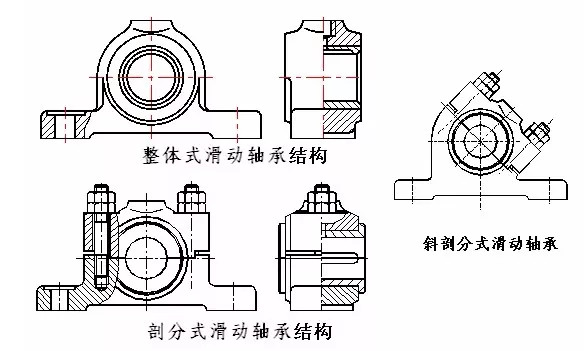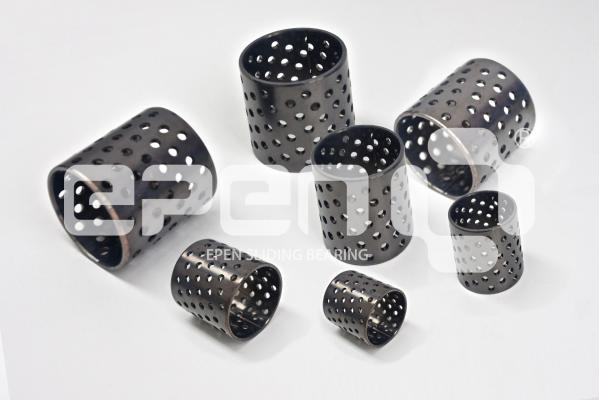The effective operation or failure of sliding bearings is closely related to the selection of load, speed, lubricating oil, and bearing geometric parameters. However, the reasonable selection of sliding bearing materials will play a decisive role in the exertion of sliding bearing capabilities. Damage to antifriction materials for sliding bearings can cause damage to related parts, so sliding bearing materials should have good wear resistance, corrosion resistance, fatigue resistance, and pollution resistance.
Overview of Plain Bearing Materials
Materials used to manufacture bearing shells and bearing liners that match the journal in sliding bearings. The main items for evaluating sliding bearing materials include: compressive strength and fatigue resistance; wear resistance; runnability; friction compatibility to prevent adhesion to the journal; compliance to compensate for poor initial fit of the sliding surface; allowing hard particles to be embedded to reduce the embedment of journal scratches; thermal conductivity; corrosion resistance; processing performance; price, etc. However, up to now, there is no bearing material that can fully meet the requirements of these projects, and many of them contradict each other. For example, the softer a metal material is, the better its compliance and embeddedness are, but the lower its strength is. Therefore, soft metal materials can only be used as bearing liners. Materials with high hardness have high strength, but their compliance and embeddedness are poor. Bearing pads made of this material require a small alignment error between the shaft and the bearing. Sliding bearing materials should be selected based on factors such as load, speed, temperature, lubrication conditions, and life. Common sliding bearing materials include babbitt alloy, copper based and aluminum based alloys, wear-resistant cast iron, plastic rubber, wood, and carbon graphite.
Babbitt alloy is a low melting point alloy mainly composed of tin, antimony, and copper, also known as a white alloy or bearing alloy. The matrix of the alloy is a solid solution soft tissue containing copper and antimony dissolved in tin, in which hard particles composed of tin copper antimony compounds are distributed. Soft tissue has good friction compatibility, compliance, and embeddedness, and hard particles have a certain ability to support loads. Babbitt alloy has low strength and can only be used as a bearing liner for mild steel, cast iron, or bronze bearings. Later, there were bearing alloys with lead, antimony, and copper as the main components. The former is called tin based babbitt alloy, and the latter is called lead based babbitt alloy. Tin based babbitt alloys have a high price and are mainly used for important bearings and large bearings for high speed and heavy loads. Lead based babbitt alloys have lower performance than tin based alloys, but they are inexpensive and widely used. They are suitable for bearings with medium speed, medium load, and relatively stable load. Adding trace elements such as chromium and beryllium to produce high-strength babbitt alloys is a new development direction.
Copper based alloys The main copper based alloys used as sliding bearing materials include brass with copper and antimony as the main components; bronze with copper and tin as the main components; and copper lead alloys. "Copper based alloys have high strength, good thermal conductivity, and wear resistance, allowing higher operating temperatures than babbitt alloys, but they are not as compliant, embeddable, and friction compatible as babbitt alloys, and can be used as bearing pads or lining materials.". The commonly used tin bronze containing tin and phosphorus is suitable for bearings with medium speed and heavy loads or subjected to impact loads; the tin bronze containing tin, zinc, and lead is suitable for bearings with medium speed and heavy loads; the lead bronze has a large bearing capacity and high fatigue strength, and is suitable for bearings with high speed and impact loads; the aluminum bronze has high strength and good corrosion resistance, and is suitable for bearings with low speed and heavy loads. Brass is generally not as good as bronze in performance, but it is cheap and mainly used for low-speed bearings. However, brass containing manganese and silicon has better performance than tin bronze.
Aluminum based alloys include aluminum antimony magnesium alloy, aluminum tin alloy, and aluminum silicon alloy. "They have high compressive strength and fatigue resistance, good thermal conductivity and corrosion resistance, and are inexpensive, but their friction compatibility, embeddedness, and compliance are poor. They are widely used in internal combustion engines and compressor bearings. Wear-resistant cast iron is inexpensive, but its friction reduction performance is poor, and can only be used in low speed and light load bearings.".
Commonly used plastics include phenolic resin, nylon, polytetrafluoroethylene, and polyformaldehyde. Plastic bearings have good self-lubrication performance, small friction coefficient, good fatigue resistance, strong vibration absorption ability, good corrosion resistance and embeddedness, can be lubricated with water or emulsion, and can save nonferrous metals. "However, plastic has lower strength than metal, poor heat resistance, low thermal conductivity, and expansion when exposed to oil or water. Therefore, a larger bearing clearance must be used in design.". Adding certain fillers such as graphite, molybdenum disulfide, and glass fiber to plastics can reduce friction coefficient and improve wear resistance; adding copper powder can improve thermal conductivity and strength. Plastic bearings have been used in industries such as metallurgy, chemicals, textiles, food, instrumentation, and shipbuilding.
Excellent rubber insertion and corrosion resistance. Rubber bearings can be lubricated with water mixed with particulate impurities, which is elastic, has a vibration damping effect, and operates smoothly, but has poor thermal conductivity. The operating temperature should be lower than 70 ℃, otherwise it is prone to aging. Natural rubber is not oil resistant, and rubber bearings that require oil lubrication should use oil resistant rubber.
Wood has self-lubrication, low cost, and good corrosion resistance. Bearings made of wood can be used in food machinery, grain processing machinery, etc. that require cleanliness and hygiene. Its operating temperature shall not be higher than 65 ℃. Hard wood such as iron pear, maple, and oak are all suitable for making wooden bearings.
Carbon graphite has excellent self-lubrication and corrosion resistance, and can withstand high temperatures of 400 ℃, but its strength is poor, and it needs to be pressed into a steel sleeve for use. This type of bearing can be used in environments where lubrication is not easy, oil contamination is not allowed, temperature is high, or there is corrosion.
Characteristics of sliding bearing materials
1.1 Friction compatibility
Adhesion occurs when the journal contacts the bearing material.
1.2 Embedding
The ability of a sliding bearing material to allow hard particles to be embedded and prevent scratches or wear. For metallic materials, low hardness and low elastic modulus have good embeddedness, while non-metallic materials may not necessarily have good embeddedness.
1.3. Runnability
The ability to reduce machining errors, coaxiality errors, and surface roughness of the journal or bearing bush during the running-in process to ensure uniform contact, thereby reducing wear force and wear.
1.4. Friction compliance
The material compensates for the initial poor performance of the sliding surface by the elastic plastic deformation of the surface layer.
1.5. Abrasion resistance
The ability of a material to resist wear and tear.
1.6. Fatigue resistance
The ability of a material to resist fatigue damage under cyclic loading. Materials with good running-in and embeddability typically have low fatigue resistance.
1.7. Corrosion resistance
The ability of materials to resist corrosion and the oxidation of lubricating oil to produce acidic substances. This acidic substance and very few additives in oil can corrode the material.
1.8. Gas resistance
The ability of a material to resist cavitation. Due to the rupture of bubbles in the oil near the solid surface, local impact high pressure or local high temperature can cause material wear.
With the development of materials science, engineering mechanics, tribology, and design theory, the material and structural design of sliding bearings have also been improved. Considering economic benefits, environmental protection, production and processing, understanding the material characteristics of sliding bearings, and selecting suitable sliding bearing materials have produced efficient, green, and energy-saving sliding bearings.
More about E94 Bushing:
E94 is deriving from E93; the difference between E93 & E94 is Indentations on working surface, which substituted by Through-holes. Theses holes will allow greater capacity to collect lubricant, which build up a lubrication film at the start of movement and reduce the frication. It is suitable for high load, lower speed application.




